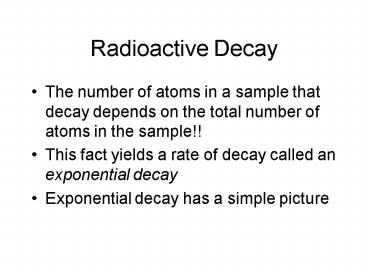Radioactive Decay - PowerPoint PPT Presentation
1 / 28
Title:
Radioactive Decay
Description:
Half-lives are unaffected by the nuclei's surroundings and only depend on what ... Since the 14C decays, after 5730 years, half of it will be gone ... – PowerPoint PPT presentation
Number of Views:228
Avg rating:3.0/5.0
Title: Radioactive Decay
1
Radioactive Decay
- The number of atoms in a sample that decay
depends on the total number of atoms in the
sample!! - This fact yields a rate of decay called an
exponential decay - Exponential decay has a simple picture
2
Exponential Decay
Decay of 226Ra
3
Half-Life
- There are a large range of half-lives seen in
nature - Half-lives are unaffected by the nucleis
surroundings and only depend on what goes on
inside the nucleus - 238U has a half-life of 4.5 billion years
4
Half-Life
- To summarize, one-half of the sample will decay
in one half-fife - One-half of that one-half will decay in the next
half life - One-half of that one-fourth will decay in the
next half life
5
Half-Life
6
Transmutations
- The changing of one element to another is called
transmutation - This occurs whenever there is an alpha decay or a
beta decay - Remember, that for a gamma decay, the nucleus
just changes internal energy levels, but doesnt
change the identity of nucleons
7
Transmutations
- Consider an alpha decay
- 238U - 234Th alpha (4He)
- Have to count the number of protons and neutrons
- Protons U-92, Th-90, He-2 Balance!!
- Neutrons U-146, Th-144, He-2 Balance!!
- Mass No. U-238, Th-234, He-4 Balance!!
8
Transmutations
- Consider a beta decay
- 234Th - 234Pa beta
- This means a neutron changed into a proton
- So mass number stays the same
- Proton number increases by one and the thorium
changes into protactinium - Actually an anti-neutrino appears also
9
Transmutations
10
Artificial Transmutation
- First example was Rutherford bombarding nitrogen
with alpha particles - 4He 14N - 17O 1H
- He viewed the reaction with a cloud chamber
- The particles left a vapor trail in the mist
11
Cloud Chamber
When you pull the piston down suddenly, you
reduce the air pressure in the chamber. This
means vapor is now super-saturated. A charged
particle acts as a nucleation seed to condense
the liquid from the vapor. This is the same
principle as cloud-seeding to make it rain.
12
Isotopic Dating
- Cosmic rays (mostly high energy protons) strike
upper atmosphere and cause transmutations that
result in many protons and neutrons being sprayed
out - Protons tend to grab electrons from other atoms
and become simple hydrogen - Neutrons keep going and smash into other atoms
13
Isotopic Dating
- When a neutron strikes nitrogen
- 1n 14N - 14C 1H
- In the atmosphere, 14C is about 1 part in 1011
- Reacts with plants just like 12C
- 14C decays via beta emission
- 14C - 14N beta half life of 5730 years
14
Carbon Dating
- When a plant dies, it stops the intake of carbon
- Since the 14C decays, after 5730 years, half of
it will be gone - We can just weigh a piece of dead wood, calculate
how much 14C it originally had and measure to how
much it has now to get the age
15
Uranium Dating
- We know the half -life of 238U and 235U
- They have series that end in 206Pb and 207Pb
- Compare how much U vs. special lead and calculate
the age of the rock!! - Carbon dating only good for about 50,000 years
- Uranium rock dating good for millions of years
16
Nuclear Fission
1n 235U - 91Kr 142Ba 31n
17
Chain Reaction
18
Chain Reaction
- The key to keeping the reaction going is that at
least one of the neutrons given off, must cause
another fission - Controlled reaction in a nuclear reactor
- If two or three cause fissions, you can get a
bomb! - Idea of critical mass
19
Critical Mass
20
Atom Bomb
21
Nuclear Reactor
22
Mass-Energy Relationship
- Einsteins famous equation E mc2
- A nucleus is measured to have less mass than the
sum of its parts - 12C has a mass exactly 12.00000 amu
- Six protons have mass 6 x 1.00728 amu
- Six neutrons have mass 6 x 1.00867 amu
- Parts have mass 12.09570 amu
23
Mass-Energy Relationship
- So, where does the mass go?
- It is the binding energy that is holding the
nucleus together - Interesting to look at the mass per nucleon as we
change the atomic number (change which element we
look at)
24
Mass-Energy Relationship
25
Nuclear Fission
26
Nuclear Fusion
27
Nuclear Energy
28
Fusion Reactions






























